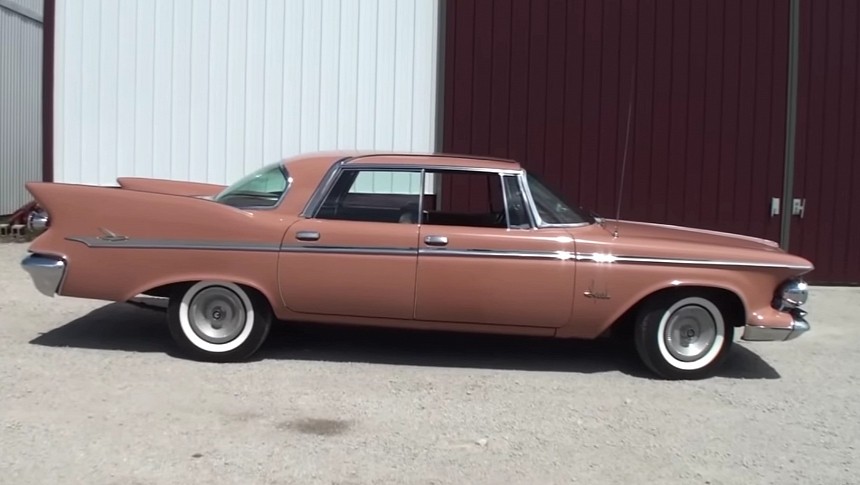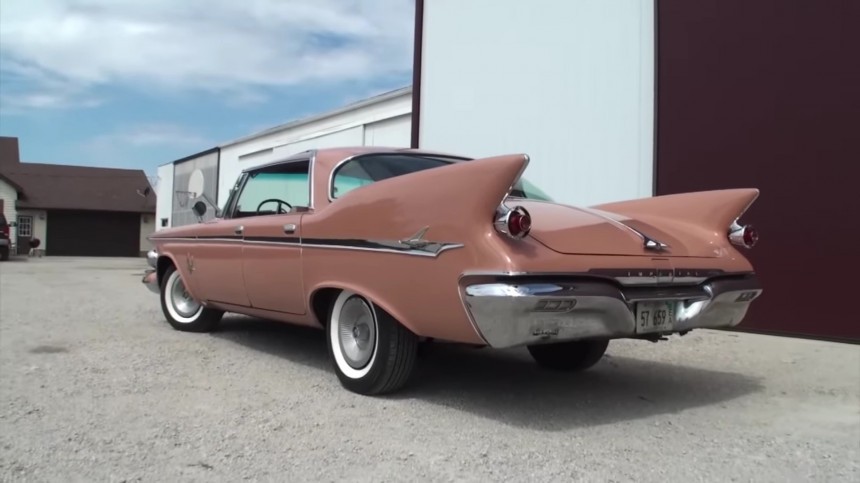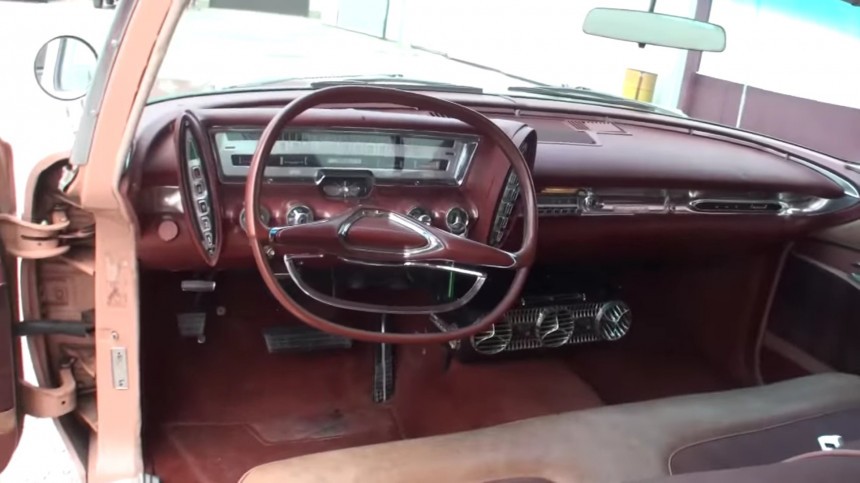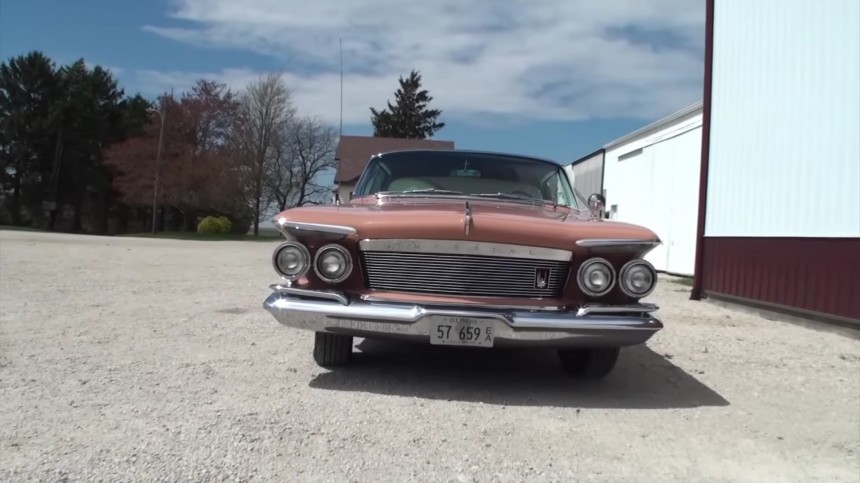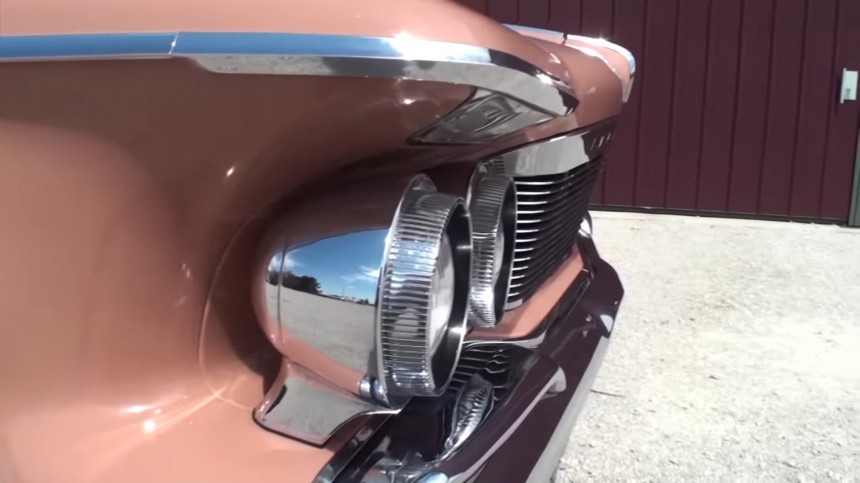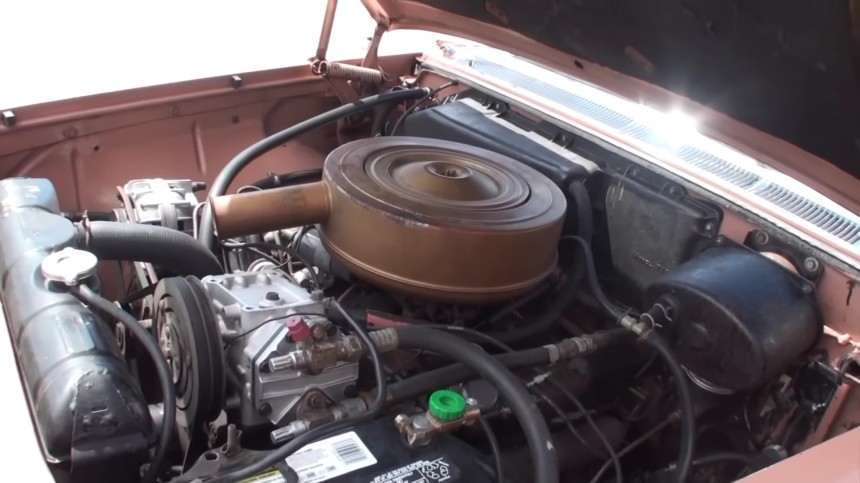1961 marked the end of a majestic era in automobile design – the flamboyant, aviation-saluting wings would feature their last display on the rear fenders of iconic cars. Adopted in the mid-50s as a sign of elegance, excellence, and enthusiasm, the oversized elements would fade out by the decade's end. Chrysler was at the forefront of fin-tail design when the fashion caught on. It would be the Pentastar who last bid farewell to the style at the beginning of the seventh decade.
Virgil Exner, the head stylist of Chrysler, was a great supporter of the vertical details for the rear end of his cars – partly for aerodynamic purposes but mostly because they drew attention. His "Forward Look" ideology was all about going low, fast, unmissed, and unmistakable. The Imperial of 1961 is perhaps the most outstanding example of "Exner Excess" in automotive history.
As the smallest of the Big Three, Chrysler couldn't take the fight to General Motors or Ford by simply making more cars. The corporation had to adopt a strategy that didn't rely on sheer numbers to outperform its Detroit rivals. After the second world war, the carmaker went with performance and looks as their main competitive advantage. While the go-fast task fell on the shoulders of the HEMI V8, the beauty was down to the styling department to solve.
When Exner pitched his Forward Look idea to the Chrysler decision-making heavyweights in the early 50s, the new paradigm received an overwhelming appraisal. So much, in fact, that it was rushed from paper to metal, to the expense of build quality. Early Chryslers penned in the new style were fabulously gorgeous but terribly unreliable. Rust was the biggest issue, and quality control was downright outrageous.
By the end of the decade, Chrysler had addressed the matters, and the cars were up to standards, ready to compete against the likes of Chevrolet, Buick, Lincoln, and Ford. Chrysler's Imperial division was so keen on quality that one in ten employees at the assembly plant was a quality inspector. Every automobile was thoroughly studied and tested to meet the highest customer demands.
On top of that, a superseding committee was in charge of post-inspection checkups. Unlike regular quality inspectors, the members of said committee would pick a ready-to-sale automobile, take it apart (literally), and write a report with absolutely everything they found. The report would be archived in a drawer if the car was good to go.
But if a single mishap were detected, Imperial's General Manager would receive a very compelling folder containing a minute recount of the issue. And that spelled Big Trouble for everyone involved in the assembly of that particular automobile and everyone responsible for every event, occurrence, or cause that led to the faulty product.
That's why Imperials were built with great care and attention to detail, quality, craftsmanship, and high-end value. That's also why it took so long to get a car to the dealers and why only 12,258 units were produced for the model year. The division claimed its vehicles to be "America's most carefully built car." A particular 1961 Custom Southampton can testify to this assertion.
Although the sales brochures boasted simplicity and classicism, the automobile is anything but. It's not a simpleton, though - the design speaks for itself. In an age where trends favored straight lines, flat surfaces, compact volumes, and an overall sense of unity, Imperial went the opposite way.
An overdose of chrome, styling cues that spelled Glamourous Luxury, and massive dimensions were the pillars of creation for this car. At 81.7 inches (2,075 mm), it was one of the widest production cars ever made. The low stance further accentuated the lateral spread of the '61 Imperial, and the car wasn't shy of drawing attention.
The wraparound windshield and rear window, the curved glass windows, and especially the massive fins atop the rear fenders were a high brow tell-tale sign. The floating front and rear lamps made quite a stir, especially when installed on the pillarless four-door hardtop.
This last idea wasn't new – Lincoln introduced the Continental featuring a similar architecture, except on Ford's luxury convertible, the rear doors were hinged on the C-pillar, suicide-style. As impressive and cool as it was, it still wasn't quite as intriguing as Imperial's classic design, where all four doors opened toward the front, effectively giving the illusion that the rear doors were suspended in thin air.
This car featured on Lou Costabile's YouTube Channel is a survivor – although the aftermarket air conditioning may chip the "originality” merits for some purists. However, over half of Imperial's 1961 total production came with the optionally installed Cool Aire air conditioning. 6,374 Imperial Customs, Crowns, and LeBarons got the $590.20 amenity. For reference, consider that this Custom Southampton retailed at $5,111 (MSRP in 1961).
For the money, the original buyer got the four-barrel single-carb 413 cubic-inch Wedge V8 (6.8-liter) – the only engine offered that year on all trims – and a three-speed push-button TorqueFlite automatic transmission. The 2.93:1 rear put the 350 hp (355 PS) and 470 lb-ft (637 Nm) to the ground.
Apart from being very wide, the Imperial Custom was proportionally long. 227.3 inches from bumper to bumper (5,773 mm), a wheelbase of 129 inches (3,276 mm), and 56.7 inches tall (1,440) – the Imperial Custom Southampton was a lot of Chrysler. (As the owner puts it, "you could fit five cheerleader in the back seat.") As a result, the four-door six-passenger luxury car weighed 4,740 lbs. (2,125 kilograms).
For a car this massive, the mileage is surprisingly friendly – the current owner of our story's hero states a 17.3 mpg score (13.6 liters per 100 km). It might sound appalling today, but it was an impressive performance in that day and age.
The body style featured in this video is the most popular of the 1961 Imperial line-up, with 4,129 built – roughly one in every three Imperials of that year came in this trim. No wonder these days, an Imperial Custom is a scarce sight.
By comparison, the marque's direct competitors had a more considerable impact on the market. At just over 25,000 units, Lincoln outsold Imperial two-to-one; but that's a shadow compared to Cadillac's 138,000 sales performance.
As the smallest of the Big Three, Chrysler couldn't take the fight to General Motors or Ford by simply making more cars. The corporation had to adopt a strategy that didn't rely on sheer numbers to outperform its Detroit rivals. After the second world war, the carmaker went with performance and looks as their main competitive advantage. While the go-fast task fell on the shoulders of the HEMI V8, the beauty was down to the styling department to solve.
When Exner pitched his Forward Look idea to the Chrysler decision-making heavyweights in the early 50s, the new paradigm received an overwhelming appraisal. So much, in fact, that it was rushed from paper to metal, to the expense of build quality. Early Chryslers penned in the new style were fabulously gorgeous but terribly unreliable. Rust was the biggest issue, and quality control was downright outrageous.
On top of that, a superseding committee was in charge of post-inspection checkups. Unlike regular quality inspectors, the members of said committee would pick a ready-to-sale automobile, take it apart (literally), and write a report with absolutely everything they found. The report would be archived in a drawer if the car was good to go.
But if a single mishap were detected, Imperial's General Manager would receive a very compelling folder containing a minute recount of the issue. And that spelled Big Trouble for everyone involved in the assembly of that particular automobile and everyone responsible for every event, occurrence, or cause that led to the faulty product.
Although the sales brochures boasted simplicity and classicism, the automobile is anything but. It's not a simpleton, though - the design speaks for itself. In an age where trends favored straight lines, flat surfaces, compact volumes, and an overall sense of unity, Imperial went the opposite way.
An overdose of chrome, styling cues that spelled Glamourous Luxury, and massive dimensions were the pillars of creation for this car. At 81.7 inches (2,075 mm), it was one of the widest production cars ever made. The low stance further accentuated the lateral spread of the '61 Imperial, and the car wasn't shy of drawing attention.
This last idea wasn't new – Lincoln introduced the Continental featuring a similar architecture, except on Ford's luxury convertible, the rear doors were hinged on the C-pillar, suicide-style. As impressive and cool as it was, it still wasn't quite as intriguing as Imperial's classic design, where all four doors opened toward the front, effectively giving the illusion that the rear doors were suspended in thin air.
This car featured on Lou Costabile's YouTube Channel is a survivor – although the aftermarket air conditioning may chip the "originality” merits for some purists. However, over half of Imperial's 1961 total production came with the optionally installed Cool Aire air conditioning. 6,374 Imperial Customs, Crowns, and LeBarons got the $590.20 amenity. For reference, consider that this Custom Southampton retailed at $5,111 (MSRP in 1961).
Apart from being very wide, the Imperial Custom was proportionally long. 227.3 inches from bumper to bumper (5,773 mm), a wheelbase of 129 inches (3,276 mm), and 56.7 inches tall (1,440) – the Imperial Custom Southampton was a lot of Chrysler. (As the owner puts it, "you could fit five cheerleader in the back seat.") As a result, the four-door six-passenger luxury car weighed 4,740 lbs. (2,125 kilograms).
For a car this massive, the mileage is surprisingly friendly – the current owner of our story's hero states a 17.3 mpg score (13.6 liters per 100 km). It might sound appalling today, but it was an impressive performance in that day and age.
By comparison, the marque's direct competitors had a more considerable impact on the market. At just over 25,000 units, Lincoln outsold Imperial two-to-one; but that's a shadow compared to Cadillac's 138,000 sales performance.
